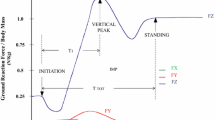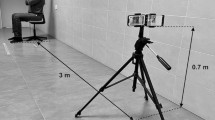Abstract
The aim of this study is to analyze a common method to measure the acceleration of a daily activity pattern by using a smartphone. In this sense, a numerical approach is proposed to transform the relative acceleration signal, recorded by a triaxial accelerometer, into an acceleration referred to an inertial reference. The integration of this acceleration allows to determine the velocity and position with respect to an inertial reference. Two different kinematic parameters are suggested to characterize the profile of the velocity during the sit-to-stand and stand-to-sit transitions for Parkinson and control subjects. The results show that a dimensionless kinematic parameter, which is linked to the time of sit-to-stand and stand-to-sit transitions, has the potential to differentiate between Parkinson and control subjects.







Similar content being viewed by others
References
Nuzik S, Lamb R, Vansant A, Hirt S (1986) Sit-to-stand movement pattern-a kinematic study. Phys Ther 66:1708–1713
Cadore EL, Izquierdo M (2013) New strategies for the concurrent strength, power, and endurance-training prescription in elderly individuals. J Am Med Dir Assoc 14:623–624
Nikfekr E, Kerr K, Attfield S, Playford DE (2002) Trunk movement in parkinson’s disease during rising from seated position. Mov Disord 17:274–282
Cadore EL, Casas-Herrero A, Zambom-Ferraresi F, Idoate F, Millor N, Gomez M, Rodriguez-Manas L, Izquierdo M (2013) Multicomponent exercises including muscle power training enhance muscle mass, power output, and functional outcomes in institutionalized frail nonagenarians. Age 36:773–785
Millor N, Lecumberri P, Gomez M, Martínez-Ramirez A, Izquierdo M (2014) Kinematic parameters to evaluate functional performance of sit-to-stand and stand-to-sit transitions using motion sensor devices: a systematic review. IEEE Trans Neural Syst Rehabil Eng 22:926–936
Movement Disorder Society Task Force on Rating Scales for Parkinson’s Disease (2003) The unified parkinson’s disease rating scale (UPDRS): status and recommendations. Mov Disord 18:738–750
Khemlani MM, Carr JH, Crosbie WJ (1999) Muscle synergies and joint linkages in sit-to-stand under two initial foot positions. Clin Biomech 14:236–246
Boonstra MC, van der Slikke RMA, Keijsers NLW, van Lummel RC, Malefijt MCD, Verdonschot N (2004) The accuracy of measuring the kinematics of rising from a chair with accelerometers and gyroscopes. J Biomechan 39:354–358
Costa J, González-Rojas HA, Valldeoriola F, Gaig C, Tolosa E, Valls-Sole J (2010) Nonlinear dynamic analysis of oscillatory repetitive movements in parkinson’s disease and essential tremor. Mov Disord 25:2577–2586
Yang SZ, Laudanski A, Li QG (2012) Inertial sensors in estimating walking speed and inclination: an evaluation of sensor error models. Med Biol Eng Comput 50:383–393
Weiss A, Herman T, Plotnik M, Brozgol M, Maidan I, Giladi N, Guerevich T, Hausdorff JM (2010) Can an accelerometer enhance the utility of the timed up, go test when evaluating patients with parkinson’s disease?. Med Eng Phys 32:119–125
Mellone S, Tacconi C, Chiari L (2012) Validity of a smartphone-based instrumented timed up and go. Gait Posture 36:163–165
Joundi RA, Brittain J-S, Jenkinson N, Green AL, Aziz T (2011) Rapid tremor frequency assessment with the iPhone acceleromete. Parkinsonism Relat Disord 17:288–290
Wile SJ, Ranawaya D, Kiss Z (2014) Smart watch accelerometry for analysis and diagnosis of tremor. J Neuroscience Methods 215:1–4
Chen PY, Wei SH, Hsieh WL, Cheen JR, Chen LK, Kao CL (2012) Lower limb power rehabilitat. (LLPR) using interactive video game for improvement of balance function in older people. Arch Gerontol Geriatrics 55:677–682
Janssen WGM, Bussmann JBJ, Horemans HLD, Stam H (2008) Validity of accelerometry in assessing the duration of the sit-to-stand movement. Med Biol Eng Comput 46:879–887
Najafi B, Aminian K, Loew F, Blanc Y, Robert PA (2002) Measurement of stand-sit and sitstand transitions using a miniature gyroscope and its application in fall risk evaluation in the elderly. IEEE Trans Biomed Eng 49:843–851
Farkas Z, Csillik A, Szirmai I, Kamondi A (2006) Asymmetry of tremor intensity and frequency in Parkinson’s disease and essential tremor. Parkinsonism Relat Disord 12:49–55
Adame ME, Al-Jawad A, Romanovas M, Hobert MA, Maetzler W, Möller K, Manoli Y (2012) TUG Test instrumentation for parkinson’s disease patients using inertial sensors and dynamic time warping (DTW). Biomed Eng 57:1071–1074
Barrantes S, Sanchez Egea AJ, Gonzalez Rojas HA, Marti MJ, Compta Y, Valldeoriola F, Simo Mezquita E, Tolosa E, Valls-Sole J (2017) Differential diagnosis between Parkinson’s disease and essential tremor using the smartphone’s accelerometer. PLoS ONE 12(8):e0183843
Salarian A, Horak FB, Zampieri C, Carlson-Kuhta P, Nutt JG, Aminian K (2010) iTUG, a sensitive and reliable measure of mobility. IEEE Trans Neural Syst Rehabil Eng 18:303–310
Ganea R, Paraschiv-Ionescu A, Bula C, Rochat S, Aminian K (2011) Multi-parametric evaluation of sit-to-stand and stand-to-sit transitions in elderly people. Med Eng Phys 33:1086–1093
Ladin Z, Flowers WC, Messner W (1989) A quantitative comparison of a position measurement system and accelerometry. J Biomechanics 22:295–308
Moe-Nilssen R (1998) A new method for evaluating motor control in gait under real-life environmental conditions. Part 1: the instrument. Clin Biomech 13:320–327
Moe-Nilssen R, Helbostad JL (2002) Trunk aceelerometry as a measure of balance control during quiet standing. Gait Posture 16:60–68
Cali M, Savio FL (2016) Accurate 3d reconstruction of a rubber membrane inflated during a bulge test to evaluate anisotropy. In: Advances on mechanics, design engineering and manufacturing. Springer International Publishing, pp 1221–1231
Lugade V, Fortune E, Morrow M, Kaufman K (2014) Validity of using tri-axial accelerometers to measure human movement- Part I: posture and movement detection. Med Eng Phys 36:169–176
Zijlstra A, Mancini M, Lindemann U, Chiari L, Zijlstra W (2012) Sit-stand and stand-sit transitions in older adults and patients with Parkinson’s disease: event detection based on motion sensors versus force plates. J Neuroeng Rehabil 9:75:1–10
Mak M, Levin O, Mizrahi J, Hui-Chan C (2002) Joint torques during sit-to-stand in healthy subjects and people with Parkinson’s disease. Clin Biomech 18:197–206
Buckley TA, Pitsikoulis C, Hass CJ (2008) Dynamic postural stability during Sit-to-Walk transitions in Parkinson disease patients. Mov Disord 23:1274–1280
Raza MA, Chaudry Q, Zaidi SMT (2017) Clinical decision support system for parkinson’s disease and related movement disorders. In: IEEE international conference on acoustics, speech and signal processing (ICASSP), 2017. 10.1109/ICASSP.2017.7952328. IEEE, pp 1108–1112
Kostikis N, Hristu-Varsakelis D, Arnaoutoglou M, Kotsavasiloglou C (2015) A smartphone-based tool for assessing parkinsonian hand tremor. IEEE Journal of Biomedical and Health Informatics 19(6):1835–1842
Acknowledgements
The authors want to acknowledge the support of the DICYT institution that belongs to the Universidad de Santiago de Chile (USACH). The authors have no other professional and/or financial affiliations that may have biased the article.
Author information
Authors and Affiliations
Corresponding author
Rights and permissions
About this article
Cite this article
González Rojas, H.A., Cuevas, P.C., Zayas Figueras, E.E. et al. Time measurement characterization of stand-to-sit and sit-to-stand transitions by using a smartphone. Med Biol Eng Comput 56, 879–888 (2018). https://doi.org/10.1007/s11517-017-1728-5
Received:
Accepted:
Published:
Issue Date:
DOI: https://doi.org/10.1007/s11517-017-1728-5




